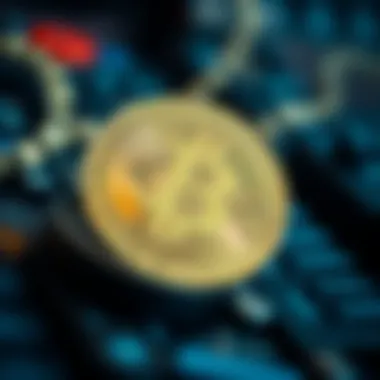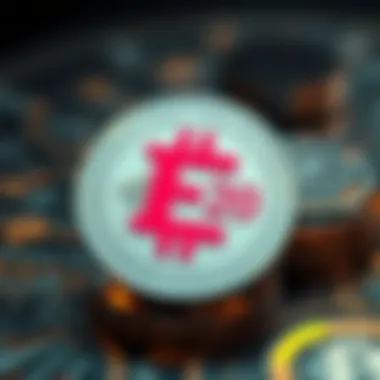Creating an ERC20 Token: A Comprehensive Guide


Intro
In recent years, the rise of cryptocurrencies has transformed the financial landscape, opening doors for innovative projects and unique strategies. Among these is the ERC20 token, a standard for tokens built on the Ethereum blockchain, enabling a vast range of functionalities. This guide aims to demystify the process of creating an ERC20 token, giving you both the fundamental knowledge and practical steps necessary to strike out on your own in this ever-evolving space.
Cryptocurrency Basics
To navigate the intricate world of ERC20 tokens, one must first grasp the foundational concepts of cryptocurrency and blockchain technology.
Understanding Blockchain Technology
At its core, blockchain is a decentralized and distributed digital ledger that records transactions across many computers. This technology ensures that all transactions are transparent, secure, and immutable. In the context of cryptocurrency, it eliminates the need for a central authority or intermediary, making it a groundbreaking innovation.
The Ethereum blockchain, specifically, allows developers to build smart contracts and decentralized applications (dApps), laying the groundwork for the creation of various tokens, including ERC20.
Key Terminology Explained
Before diving deep into ERC20 development, it’s essential to familiarize oneself with some key terms:
- Token: A digital asset created on a blockchain, representing various assets or utilities.
- Smart Contract: A self-executing contract with the terms of the agreement directly written into code.
- Ethereum Virtual Machine (EVM): The environment for executing smart contracts written on the Ethereum blockchain.
By understanding these concepts, you can build a solid foundation for your token development journey. Each term represents a crucial piece of the puzzle in the Ethereum ecosystem.
The Importance of ERC20 Tokens
ERC20 tokens stand as a crucial element in the blockchain world. Their standardization allows for easy integration with wallets, exchanges, and other smart contracts. This interoperability is what fundamentally drives the token economy forward, making it possible for developers and users alike to seamlessly interact within the Ethereum network.
The creation of an ERC20 token can facilitate various purposes, from raising funds through Initial Coin Offerings (ICOs) to launching unique gaming platforms or decentralized finance (DeFi) applications.
Key Components of ERC20 Token Creation
When it comes to actually creating an ERC20 token, certain core components are vital:
- Token Name: This is the public name that identifies your token, making it recognizable.
- Token Symbol: A short code that represents your token, similar to how stock tickers function.
- Total Supply: The maximum number of tokens that can ever exist, influencing its market value.
- Decimals: This determines how divisible your token can be, impacting transaction flexibility.
The process itself involves deploying a smart contract that adheres to the ERC20 standard, ensuring all necessary functions are included. Below is an example of a simple ERC20 contract code:
solidity // SPDX-License-Identifier: MIT pragma solidity ^0.8.0;
contract MyToken is ERC20 constructor(uint256 initialSupply) ERC20("MyToken", "MTK") _mint(msg.sender, initialSupply);
This basic implementation uses the OpenZeppelin library, a well-respected toolkit for smart contract development. Writing clear, maintainable code isn’t just good practice; it’s vital for future updates and debugging.
Key Variables and Functions Explained


Understanding the key variables and functions in the ERC20 smart contract is fundamental to effective token development. Here are some of the primary components:
- Name and Symbol: This is what users will recognize your token as. Choose something that resonates with the ethos or purpose of your project.
- Total Supply: This variable sets the maximum amount of tokens that will ever exist. Adjusting this can directly impact market perception.
- Transfer Functions: Functions like and dictate how tokens move between wallets. Proper implementation ensures accurate token movement without errors.
"Every token is unique. Just like fingerprints, they all have their own identity and purpose."
Moreover, be aware that implementing robust error handling for each function is crucial. Tokens should follow a logical flow of commands to prevent issues such as overflow errors or unauthorized transfers. Each function serves a purpose, and a deep understanding of them can prevent headaches down the road.
In summary, each of these steps is critical in the creation process of an ERC20 token. From setting up your environment to writing clean and effective smart contract code and understanding the underlying variables, they collectively contribute to a successful token generation process. Doing so enhances not only your historical grasp of token standards but positions you well within the competitive market of cryptocurrencies.
Testing Your ERC20 Token
Testing is one of the most critical phases in the creation of an ERC20 token. When crafting a token, ensuring that it functions as intended and is free from critical bugs can mean the difference between success and failure. This part of the guide offers insights into three vital processes: unit testing, transaction simulation, and contract verification. Each element plays a significant role in the overall reliability and security of your token.
Conducting Unit Tests for Smart Contracts
Unit testing focuses on verifying that each function in your smart contract behaves as expected. Think of it as closely inspecting a car before you take it on a long drive. If one small piece isn't functioning properly, it could cause chaos down the road. In the context of an ERC20 token, there are various functions to test, such as , , and .
When you create your tests, consider breaking them down into individual scenarios:
- Basic functionality: Check if tokens can be transferred correctly between accounts.
- Allowance tests: Ensure that when accounts approve others to spend tokens on their behalf, the allowance works seamlessly.
- Edge cases: Test what happens when trying to transfer tokens in insufficient balances or when hitting edge cases like integer overflow.
Using frameworks like Truffle or Hardhat, developers can write automated tests in Solidity or JavaScript. This practice not only saves time but also increases the chances of catching bugs before deployment. Remember to run these tests multiple times to confirm consistent results.
Simulating Transactions on Test Networks
Using test networks is a no-brainer when you're looking to mimic the Ethereum environment without spending real Ether. For ERC20 tokens, these test nets serve as the ultimate sandbox where developers can experiment without fear of costly mistakes. Popular test networks include Ropsten, Rinkeby, and Kovan.
By deploying your contract on one of these platforms, you can:
- Observe transaction fees: Understand how gas costs fluctuate in real situations.
- Test user interaction: Simulate how users will interact with your token by performing transactions, transfers, and allowances.
- Identify potential issues: Spot any issues early on, such as timeouts or gas limit problems that may not have appeared during unit tests.
This phase involves creating a wallet, acquiring test Ether, and deploying your ERC20 token. By doing so, you get an accurate feel of how your token would behave in a live environment.
Verifying Contract Implementation
Verification is like giving your smart contract a diploma. Once you've successfully tested and deployed, it is crucial to verify the implementation on a blockchain explorer like Etherscan. This step enhances trust and transparency among users, as anyone can review the source code and confirm that it corresponds to the deployed contract.
To verify your contract, you will need to:
- Compile your smart contract: Ensure it is optimized and ready for verification.
- Upload the source code: Use the interface provided by Etherscan to submit your contract’s source code.
- Match the compiler version: Ensure that the compiler version used matches the one declared during the deployment.
By taking these steps, you not only bolster the security of your token but also gain credibility among investors and users. The better the transparency and security, the more likely your token will garner support in the competitive crypto space.
"Testing is the most important phase of software development. It can prevent a lot of heartaches down the line."


Deploying the ERC20 Token
When you finally reach the deployment phase of your ERC20 token, it’s akin to sending a ship off into uncharted waters. Here, you are not just pushing your code live; you are entrusting the token to the Ethereum network, with all its intricacies and unpredictabilities. This step carries profound importance, as choosing the right method and environment can dictate how your token will interact in the broader ecosystem. A misstep can lead to headaches down the line, forming an obstacle for both you and your users. Hence, understanding the various aspects of deployment is crucial.
Choosing the Right Ethereum Network for Deployment
Selecting the right Ethereum network for deploying your ERC20 token is like picking the perfect stage for your performance. Each network holds unique traits that might align with the objectives of your token. There are main networks and a variety of test networks to consider.
- Ethereum Mainnet: This is where the rubber meets the road. Deploying on the mainnet means your token will be live, and transactions will carry real value. However, costs here can accumulate rapidly in the form of gas fees, especially during high-traffic periods.
- Test Networks (Rinkeby, Ropsten, Kovan): Before you commit your token to the mainnet, it’s wise to practice in a test environment. These networks allow you to simulate transactions without financial repercussions. You can fine-tune your token’s mechanics, ensuring everything runs smoothly before the big launch.
- Polygon and Binance Smart Chain: These are popular alternative networks that also support ERC20 tokens but often offer lower fees and faster transaction times compared to Ethereum’s mainnet. Consider them for projects that expect high volume but wish to keep costs lower.
It’s fascinating how each option comes with its pros and cons. When making your choice, weigh the potential traffic your token might attract, the transaction speed you desire, and your budget constraints.
Deployment Procedures and Best Practices
When it comes to deployment, the right procedures can save you from a world of hurt later. You wouldn’t want to sail without a map, right? Here are some shrewd practices:
- Verify Contracts: Before anything goes live, use tools like Etherscan to verify your smart contract's code. This transparency helps build trust among potential users.
- Use Deployment Tools: Tools like Truffle or Hardhat facilitate smoother deployment processes. They automate various tasks and handle testing, which can mitigate errors that might occur if you go about it manually.
- Gas Management: Pay close attention to gas fees during the deployment. Deploying during peak activity times can lead to exorbitant fees. Monitor gas prices using sites like ETH Gas Station to optimize your timing.
“A diligent deployment is worth its weight in gold; a hasty one, a penny dreadful.”
This proverb rings true in our token deployment. Ensuring a seamless deployment allows you to concentrate on the token’s utility and growth rather than getting bogged down in post-deployment chaos.
Handling Post-Deployment Tasks
After the dust settles from deployment, the work isn’t quite finished. Post-deployment tasks are critical to ensuring that your ERC20 token remains relevant and functional.
- Community Engagement: Foster a community around your token. This could involve an active social media presence, regular updates, and open lines of communication. Tools like Discord or Reddit can be effective platforms for this.
- Monitor Transactions: Keep an eye on how your token is being utilized. Are users engaging with it as you expected? Tools such as Dune Analytics can give you insights into the transaction data.
- Implement Updates: Changes and improvements based on user feedback may be necessary. Make it a habit to periodically review and revise the smart contract. Upgradable contracts can help you introduce new features without losing the existing token.
In summary, deploying your ERC20 token is an intricate dance of planning, execution, and post-launch maintenance. Pay attention to each stage, and you’ll set up a sturdy foundation for your token’s journey in the blockchain universe.
Maintaining ERC20 Tokens
Maintaining ERC20 tokens is a crucial facet of token management. This stage often gets overshadowed by the initial creation and deployment phases, yet it holds the key to sustaining the token's lifecycle and ensuring long-term usability. The importance cannot be overstated; as the crypto space evolves, so do the needs and expectations of token holders and users. Regular maintenance not only keeps the token functioning well but also helps in building trust within the community, which is essential for any token's success.
Regular Updates and Community Engagement
Engaging with the community and providing regular updates is vital for the health of an ERC20 token. A token that remains static risks fading into obscurity. Regular updates can include technical improvements, feature enhancements, or even minor adjustments based on community feedback. This proactive approach keeps the community in the loop and fosters a sense of belonging and investment in the token's future.
- Importance of Communication: By maintaining an open line of communication with users, developers can quickly address any concerns or misconceptions that arise.
- Benefits for Developers: Engaging with your community helps in gathering valuable insights that can inform future updates and roadmaps. Users who feel valued are more likely to advocate for your token, thereby enlarging its reach.
- Potential Platforms for Engagement: Consider forums such as Reddit, Telegram, or specialized groups on Discord to hold discussions, share updates, and answer questions. Utilizing these platforms effectively can significantly enhance community interaction.
Active participation breeds loyalty; a community that feels heard will stand behind you even during turbulent times.
Addressing Security Vulnerabilities
Security is a significant concern in the blockchain landscape. Maintaining an ERC20 token involves constantly monitoring and addressing potential vulnerabilities. The dynamic nature of cyber threats demands a proactive approach.


- Regular Audits: Conducting regular security audits is non-negotiable. External auditing firms can provide a fresh perspective on potential flaws that may have evaded the original developers' notice.
- Bug Bounties: Implementing bug bounty programs encourages ethical hackers to identify vulnerabilities. This strategy not only enhances security but also creates a culture of transparency, showcasing that you prioritize the safety of your community.
- Timely Patching: When vulnerabilities are identified, acting on them quickly is essential. Delays can lead to significant financial loss or a tarnished reputation.
Maintaining an ERC20 token is not merely a tech responsibility; it is a commitment to your users. By actively engaging them and addressing security risks, you reinforce the integrity and viability of the token. For a comprehensive understanding of smart contract security practices, resources like OpenZeppelin and CryptoSecurity can be valuable.
Common Challenges in Token Creation
Creating an ERC20 token may appear as a straightforward process on the surface, but underneath lies a myriad of challenges that can dictate the success or failure of a project. These challenges can range from compliance with regulations to the necessity of standing out in a saturated market. Understanding these hurdles is crucial for anyone looking to navigate the often-turbulent waters of token creation. By recognizing these potential pitfalls ahead of time, developers are better positioned to address them effectively, ensuring their tokens fulfill their intended purpose and find their rightful spot in the crypto ecosystem.
Understanding Regulatory Compliance
One of the foremost challenges in the creation of an ERC20 token is navigating the complex landscape of regulatory compliance. Compliance isn’t just a rote task; it can be the difference between a thriving token and hefty fines or worse – legal troubles.
Governments around the world are still grasping the implications of cryptocurrencies and tokens. As such, regulations can vary dramatically from one jurisdiction to another. Contentious issues like securities classifications can cause headaches. Are you issuing a utility token, or does it inadvertently qualify as a security? These distinctions matter and must guide your drafting process.
For example, in the United States, the Securities and Exchange Commission (SEC) has specific guidelines regarding the classification of tokens. Not being compliant could ensnare your project in regulatory crosshairs, leading to unwanted scrutiny. To avoid this, it’s advisable to consult with legal experts well-versed in cryptocurrency laws. Engaging with them early in the planning stages can save you a world of trouble down the line.
- Know Your Jurisdiction: Research local laws and ensure your token aligns with them.
- Document Everything: Maintain thorough records of your token’s purpose and functionality. As regulations can change, having documented evidence of your compliance efforts can be invaluable.
- Adapt to Changes: Regulations are fluid. Being flexible and ready to pivot can save your project.
"In the domain of cryptocurrency, ignorance of the law is not bliss. It's a recipe for disaster."
Managing Market Competition
Once you’ve sorted out compliance, the next major hurdle lies in market competition. The crypto landscape is crowded, with thousands of tokens vying for attention. To carve out a niche, you must think strategically. Simply creating a token isn’t enough; the key is to offer unique value that stands out.
For many developers, it’s tempting to follow trends, but this method is fraught with risk. Tokens that mimic existing successful models without adding any fresh ideas tend to sink without a trace. To truly flourish, here are a few strategies:
- Conduct Market Research: Understand what users are lacking and how your token can fill that gap. Identifying a unique selling point can help differentiate your project.
- Build a Strong Community: Engage potential users early on. A vibrant community can propel your token forward through word-of-mouth and social proof.
- Focus on Utility: Tokens that serve a clear purpose tend to retain value and a loyal user base. Assess how your token can facilitate processes or transactions that audiences find valuable.
The combination of regulatory awareness and competitive differentiating strategies lays the groundwork for a robust token project in a challenging ecosystem. Awareness and adaptability are crucial. Recognizing these common roadblocks can help you steer clear of unnecessary pitfalls, allowing you to focus on what truly matters: building a meaningful and successful ERC20 token.
Ending and Future of ERC20 Tokens
As we wrap up this comprehensive guide on creating ERC20 tokens, it's imperative to highlight the significance of understanding not just the current landscape but also the evolving trajectory of token standards within the Ethereum ecosystem. The ties between ERC20 tokens and the broader crypto economy cannot be overstated—these tokens serve as the lifeblood of countless decentralized applications and financial instruments.
In the conclusion, we reflect on the importance of ERC20 tokens in providing a standardized framework that enhances interoperability among various cryptocurrency platforms. With clear specifications, developers can craft tokens that communicate seamlessly with wallets, exchanges, and other decentralized applications. This accessibility encourages innovation and adoption, paving the way for more complex and transformative projects.
The Evolving Nature of Blockchain Standards
The realm of blockchain technology is in perpetual motion. New standards and protocols emerge as the industry matures and users' demands evolve. ERC20, while significant, isn’t a static framework. The advent of ERC721 and ERC1155 standards highlighted the need for diversification, addressing differences in token use cases—from fungible tokens to non-fungible assets and multi-token standards. This shift showcases the adaptability of smart contracts, meaning developers can find tailored solutions to distinct challenges.
Moreover, the growing trend toward interoperability—exemplified by solutions like Polkadot and Cosmos—suggests that future token standards may not only focus on the Ethereum blockchain but also emphasize cross-chain functionality. This provides a broader avenue for asset exchange and collaboration, fostering a more interconnected cryptocurrency ecosystem, where every party benefits from collective advancements in technology.
Potential Innovations in Token Design
Looking ahead, the horizon is replete with potential innovations in token design that promise to enhance the utility and functionality of ERC20 tokens. As decentralized finance (DeFi) continues to burgeon, we see the rise of innovative models that integrate features like yield farming mechanisms, staking protocols, and governance models within token frameworks. Developers are beginning to think outside the box, potentially incorporating regulatory considerations from the outset to navigate compliance more easily.
Furthermore, the integration of artificial intelligence in tokenomics could push boundaries even further. Imagine an ERC20 token equipped with AI algorithms learning and adjusting its utility based on market conditions and user behavior, an intelligent token that reacts and adapts to maximize value for its holders.
“Innovation distinguishes between a leader and a follower.” — Steve Jobs
For more insights and updates in this rapidly changing landscape, consider keeping an eye on resources such as Wikipedia's overview, CoinDesk, and Reddit where relevant discussions unfold.



